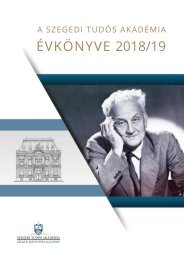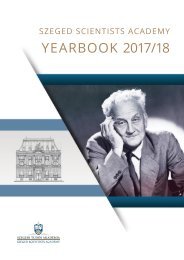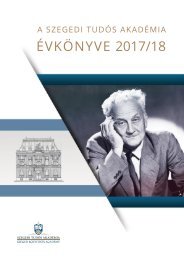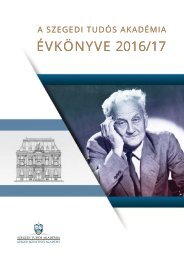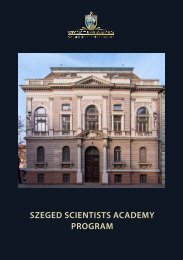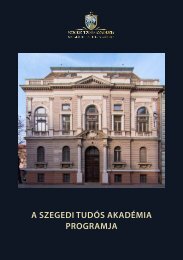SzSA YearBook 2016/17
Create successful ePaper yourself
Turn your PDF publications into a flip-book with our unique Google optimized e-Paper software.
SZENT-GYÖRGYI MENTORS<br />
TAMÁS CSONT<br />
Department of Biochemistry,<br />
Faculty of Medicine,<br />
University of Szeged<br />
Address: Dóm tér 9., H-6720 Szeged, Hungary<br />
E: csont.tamas@med.u-szeged.hu<br />
T: +36 62/545-755<br />
RESEARCH AREA<br />
Cardiovascular diseases and especially acute myocardial infarction<br />
are among the leading causes of death worldwide.<br />
Although prevention and the therapy of myocardial infarction<br />
have been significantly improved in the last decades,<br />
mortality is still unacceptably high. Therefore, development<br />
of new therapies aiming to attenuate infarct size is very relevant.<br />
Thus, our research group investigates the molecular<br />
mechanisms of infarction as well as the adaptive responses<br />
of the myocardium to ischemic stress (pre- and postconditioning)<br />
to develop novel potential therapies for the treatment<br />
of myocardial infarction. Since the risk of myocardial<br />
infarction is increased by the presence of several co-morbidities<br />
and risk factors including high cholesterol level,<br />
diabetes, obesity, hypertension, smoking, lack of exercise,<br />
kidney failure, etc., we also look at the effects of certain risk<br />
factors on the myocardium as well as on adaptive mechanisms<br />
of the heart.<br />
TECHNIQUES AVAILABLE IN THE LAB<br />
Induction and treatment of disease models (e.g. diabetes,<br />
hypercholesterolemia) in experimental animals, echocardiographic<br />
assessment of cardiac morphology and function,<br />
surgical interventions to induce disease models (myocardial<br />
infarction, heart failure, kidney failure, etc.), isolated<br />
heart perfusion, determination of infarct size, induction and<br />
maintenance of cell culture, viability assays, transfection,<br />
general biochemical methods to determine metabolites,<br />
proteins and nucleic acids (spectroscopy, western blot,<br />
ELISA, flow cytometry, histochemistry, PCR, etc.).<br />
SELECTED PUBLICATIONS<br />
Sárközy, M., Szűcs, G., Fekete, V., Pipicz, M., Éder, K., Gáspár,<br />
R., Sója, A., Pipis, J., Ferdinandy, P., Csonka, C., Csont, T. (<strong>2016</strong>)<br />
Transcriptomic alterations in the heart of non-obese type 2<br />
diabetic Goto-Kakizaki rats. Cardiovasc Diabetol 15: 110.<br />
Pipicz, M., Varga, Z.V., Kupai, K., Gáspár, R., Kocsis, G.F.,<br />
Csonka, C., Csont, T. (2015) Rapid ventricular pacinginduced<br />
postconditioning attenuates reperfusion injury:<br />
effects on peroxynitrite, RISK and SAFE pathways. Br J<br />
Pharmacol <strong>17</strong>2: 3472-83.<br />
Varga, Z.V., Kupai, K., Szűcs, G., Gáspár, R., Pálóczi, J.,<br />
Faragó, N., Zvara, A., Puskás, L.G., Rázga, Z., Tiszlavicz, L.,<br />
Bencsik, P., Görbe, A., Csonka, C., Ferdinandy, P., Csont, T.<br />
(2013) MicroRNA- 25-dependent up-regulation of NADPH<br />
oxidase 4 (NOX4) mediates hypercholesterolemia-induced<br />
oxidative/nitrative stress and subsequent dysfunction in<br />
the heart. J Mol Cell Cardiol 62: 111-21.<br />
Kocsis, G.F., Sárközy, M., Bencsik, P., Pipicz, M., Varga, Z.V.,<br />
Pálóczi, J., Csonka, C., Ferdinandy, P., Csont, T. (2012) Preconditioning<br />
protects the heart in a prolonged uremic<br />
condition. Am J Physiol Heart Circ Physiol 303: H1229-36.<br />
Csont, T., Görbe, A., Bereczki, E., Szunyog, A., Aypar, E., Tóth,<br />
M.E., Varga, Z.V., Csonka, C., Fülöp, F., Sántha, M., Ferdinandy,<br />
P. (2010) Biglycan protects cardiomyocytes against hypoxia/<br />
reoxygenation injury: role of nitric oxide. J Mol Cell Cardiol<br />
48: 649-52.<br />
43







